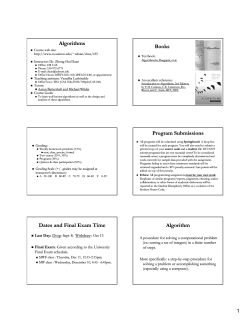
PhEMA: Phenotype Execution and Modeling Architecture
PhEMA: Phenotype Execution and Modeling Architecture NIGMS: R01 GM105688 projectphema.org Jyotishman Pathak – P.I. (Mayo Clinic) Joshua Denny – P.I. (Vanderbilt University) William Thompson – P.I. (NorthShore University HealthSystem) Enid Montague – Human Factors (Site P.I. at Northwestern) Luke Rasmussen – Architect Huan Mo – Execution Engine Development Guoqian Jiang – Standards Interoperability April 23, 2015 EHR-Driven Phenotpying I Phenotyping is the process of selecting cohorts based on clinically relevant observable features I The identification of patient cohorts for clinical and genomic research is a costly and time-consuming process I Leveraging EHRs for identifying patient cohorts has become an increasingly attractive option From a research perspective, integrated data constitute a computable collection of fine-grained longitudinal phenotypic profiles, facilitating cohort-wide investigations and knowledge discovery on an unprecedented scale. P. B. Jensen, L. J. Jensen, and Brunak (2012) “Mining electronic health records” Current Practice of EHR-Driven Phenotpying I A key component for identifying patient cohorts in the EHR is to define inclusion and exclusion criteria that select sets of patients based on stored clinical data I Phenotyping logic can be quite complex, and typically includes both Boolean and temporal operators applied to multiple clinical events. I The phenotyping algorithm development process is a multi-disciplinary team effort, including clinicians, domain experts, and informaticians I The typical way to share phenotyping algorithms across institutions is through the use of informal free text descriptions of algorithm logic, possibly augmented with graphical flowcharts and simple lists of structured codes. I Algorithms are operationalized as database queries and software, customized to the local EHR environment. Electronic Medical Records and Genomics Network Gottesman, Kuivaniemi, et al. (2013) “The Electronic Medical Records and Genomics (eMERGE) Network” I NHGRI funded project in 8th year (2nd funding cycle; 3rd starting soon) I Development of methods and best practices for using the EHR as a tool for genomic research I Network members link EHR data to DNA biobanks, pool results across sites I Several dozen electronic phenotypes completed and in progress (www.PheKB.org) Example Phenotypes: Type 2 Diabetes, Peripheral Arterial Disease, QRS Duration, Colon Polyps, Hypothyroidism Example Algorithm: Hypothyroidism Malinowski, Denny, et al. (2014) “Genetic variants associated with serum thyroid stimulating hormone (TSH) levels in European Americans and African Americans from the eMERGE Network” Phenotyping Workflow Phenotyping Workflow Thompson, Rasmussen, et al. (2012) “An evaluation of the NQF Quality Data Model for representing Electronic Health Record driven phenotyping algorithms” Key Lessons Learned from eMERGE I Algorithm design and transportability I I I I I Non-trivial; requires significant expert involvement Highly iterative process Time-consuming manual chart reviews Representation of “phenotype logic” is critical Standardized data access and representation I I I Importance of unified vocabularies, data elements, and value sets Questionable reliability of ICD & CPT codes (e.g., billing the wrong code since it is easier to find) Natural Language Processing (NLP) is critical Kho, J. A. Pacheco, et al. (2011) “Electronic Medical Records for Genetic Research” Target Phenotyping Workflow Project Goal and Aims Goal: The proposed project will design, build and promote an open-access community infrastructure for standards-based development and sharing of phenotyping algorithms, as well as provide tools and resources for investigators, researchers and their informatics support staff to implement and execute the algorithms on native EHR data. Aims: I To create a standards-based information model for representing phenotyping algorithms. I To create an open-access repository and infrastructure for authoring, sharing and accessing computable, standardized phenotyping algorithms. I To develop informatics methods and tools for translating phenotyping algorithmic criteria into EHR-based executable queries. Phenotype KnowledgeBase (PheKB) Phenotype Authoring Tool Phenotype Execution Environment – JBoss Drools Li, Endle, et al. (2012) “Modeling and executing electronic health records driven phenotyping algorithms using the NQF Quality Data Model and JBoss Drools Engine” Phenotype Execution Environment – KNIME Mo, J. Pacheco, et al. (2015) “A prototype for executable and portable electronic clinical quality measures using the KNIME analytics platform” References I Omri Gottesman et al. “The Electronic Medical Records and Genomics (eMERGE) Network: past, present, and future”. In: Genetics in medicine: official journal of the American College of Medical Genetics (June 6, 2013). ISSN: 1530-0366. DOI: 10.1038/gim.2013.72. Peter B. Jensen, Lars J. Jensen, and Søren Brunak. “Mining electronic health records: towards better research applications and clinical care”. In: Nature Reviews. Genetics 13.6 (June 2012), pp. 395–405. ISSN: 1471-0064. DOI: 10.1038/nrg3208. References II A. N. Kho et al. “Electronic Medical Records for Genetic Research: Results of the eMERGE Consortium”. In: Science Translational Medicine 3.79 (Apr. 20, 2011), 79re1–79re1. ISSN: 1946-6234, 1946-6242. DOI: 10.1126/scitranslmed.3001807. URL: http://stm.sciencemag.org/cgi/doi/10.1126/ scitranslmed.3001807 (visited on 07/18/2014). Dingcheng Li et al. “Modeling and executing electronic health records driven phenotyping algorithms using the NQF Quality Data Model and JBoss Drools Engine”. In: AMIA ... Annual Symposium proceedings / AMIA Symposium. AMIA Symposium 2012 (2012), pp. 532–541. ISSN: 1942-597X. References III Jennifer R. Malinowski et al. “Genetic variants associated with serum thyroid stimulating hormone (TSH) levels in European Americans and African Americans from the eMERGE Network”. In: PloS One 9.12 (2014), e111301. ISSN: 1932-6203. DOI: 10.1371/journal.pone.0111301. Huan Mo et al. “A prototype for executable and portable electronic clinical quality measures using the KNIME analytics platform”. In: AMIA Summits Transl Sci Proc. 2015. William K. Thompson et al. “An evaluation of the NQF Quality Data Model for representing Electronic Health Record driven phenotyping algorithms”. In: AMIA Annual Symposium Proceedings. Vol. 2012. 2012, p. 911. URL: http://www. ncbi.nlm.nih.gov/pmc/articles/PMC3540514/ (visited on 08/29/2013).
© Copyright 2025










